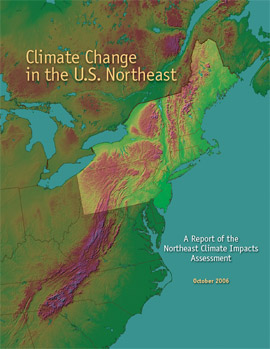How will climate change impact the U.S. Northeast?
How will climate change impact the U.S. Northeast?
mongabay.com
July 11, 2007
Under a “high emissions” scenario big changes are in store for the northeastern United States, according to a new study.
The Northeastern United States could experience widespread changes from global warming if greenhouse gas emission are not significantly reined in, warns a new report from the Union of Concerned Scientists (UCS) and a team of more than 50 scientists and economists.
“Global warming represents an enormous challenge, but we can meet it if we act swiftly,” said Peter Frumhoff, director of science and policy at UCS. “Our response to global warming in the next few years will shape the climate our children and grandchildren inherit.”
The two-year study shows that under the higher-emissions scenario, winters in the Northeast could warm by 8°F to 12°F and summers by 6°F to 14°F above historic levels by late this century, while sea levels could rise 10 to 23 inches, a magnitude that would produce “100-year” floods every two to four years on average by mid-century and almost annually by the end of the century. The low emissions projections are not much better: Northeast winters would warm 5°F to 8°F above historic levels by late-century, and summers by 3°F to 7°F, while sea levels would climb 7 to 14 inches.
 The cover of the 2006 UCS report on the Northeast
|
The scientists say that climate change will affect U.S. agriculture, cutting milk production 5-20 percent across much of the region and shifting ideal growing conditions for apples, blueberries, and cranberries northward by mid-century. Similar shifts are expect for marine life, including important seafood species like lobster and cod.
Skiers and winter outdoor enthusiasts will also be at a disadvantage. Under the higher-emissions scenario, only western Maine would retain a reliable ski season by the end of the century and only northern New Hampshire would support a snowmobiling season longer than two months, according to the report.
Given these forecasts, the researchers urge Northeastern states to reduce emissions by 3 percent annually until mid-century — or 80 percent below 2000 levels by 2050. The authors say this may already be happening, citing the Regional Greenhouse Gas Initiative — “the first multistate, market-based plan to reduce heat-trapping emissions from power plants — signed by Connecticut, Maine, Massachusetts, New Hampshire, New Jersey, New York, Pennsylvania, and Rhode Island.
“The Northeast has a tremendous opportunity to help lead us to a secure climate future. Fortunately, more and more people understand the stakes and are mobilizing around the problem,” said James McCarthy, professor of biological oceanography at Harvard University, vice-chair of the NECIA, and president-elect of the American Association for the Advancement of Science. “The time to act is now.”














